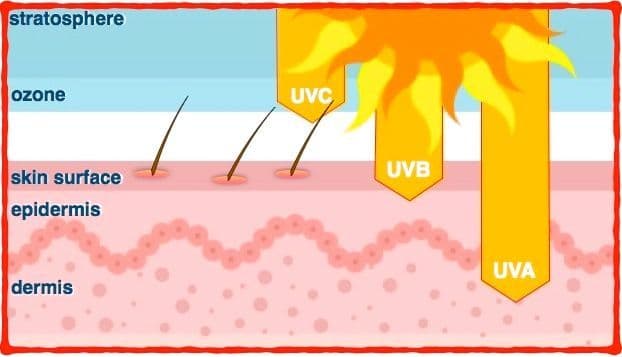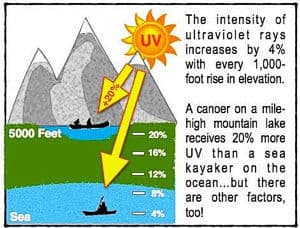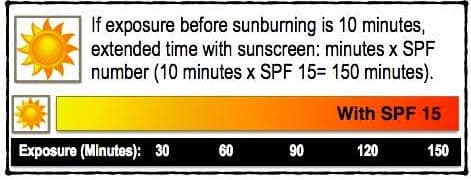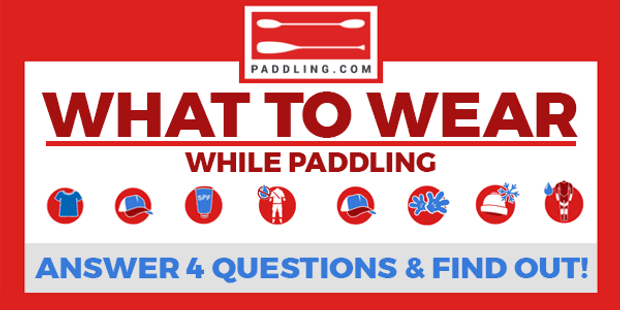Sun Protection Primer for Paddlers
A month before paddling on the surreal clarity of the Caribbean Sea just off the island of Roatan, I had spent several hours basking in the bluish glow of a fake-n-bake tanning booth in an effort to prepare my pale Minnesota skin to the exposure of the unrelenting UV rays of the Honduran sun... I should have spent the money on a couple bottles of SPF 50-rated sunscreen!
For the casual sun-worshipper, sunlight has a high vanity factor for those seeking the ultimate glowing tans of summer. For others, it's enjoying the simple pleasures of a healthy, invigorating wash of warmth bathing our body as we enjoy the great outdoors.
But there's an evil side to this golden wash of sunshine - the unseen ultraviolet rays that radiate out beyond the range of the visible-to-humans portion of the light spectrum. Too much exposure from this radiation has been linked to accelerated skin aging, sunburn and skin cancer. For most sunny day paddlers (or even those under cloud cover), exposure to the sun warrants the same level of safety awareness we have towards wearing a PFD.
Let's start by reviewing a solar radiation glossy of terms, most often expressed as letter/number triplets such as UPF, UVA, SPF15 and so on…
The electromagnetic (light) spectrum is divided into ranges defined by wavelengths. If we consider visible light in the middle of a long, horizontal bar, the longer red waves are on the left, and shorter violet ones on the right. Extending beyond the red rays are the even longer infrared leading further out to the microwaves portion of this horizontal bar. Further along the right where the waves get progressively shorter are the ultraviolet lengths, these diminishing even further as they approach the x-ray range of the spectrum. When we are discussing the effects of the sun on our human bodies, we are talking about the rays in the ultraviolet range of this solar spectrum.
Wondering what to wear when going paddling? Answer 4 quick questions and instantly learn what you need to wear for your next paddling trip!
Three Types of Ultraviolet Rays
There are three types of ultraviolet rays: UVA, UVB and UVC:
UVA - rays between 320-400 billionths of an inch in wavelength, makes up 95% of the UV radiation reaching the earth, can cause premature skin aging, wrinkling and skin cancer; penetrates deep into skin than do UVB rays; are always a threat any time of the day; can penetrate untreated glass and clouds
UVB - slightly shorter, about 5%-10% reach the earth, these cause reddening of the skin and sunburn and may lead to skin aging and cancer (by suppressing our immune system). These are most dangerous between 10am and 4pm, can penetrate clouds, but not glass
UVC - The shortest and deadliest! But fear not, unless you are paddling in the exo-sphere without a space suit, you're OK, most of these rays are absorbed by atmospheric gases/the ozone layer before ever reaching the earth's surface.

SPF, UPF, and Your Skin Type
SPF (Sun Protection Factor) - used to designate the factor of time it takes UVB rays to redden skin covered by sunscreen than it would without sunscreen. SPF15 means it will that 15 times longer to redden with sunscreen than it does without. Typically if you divide 100 by this number, you get the percentage of UV blockage provided by the sunscreen, (doing the math give us SPF15: 100/15= approximately 7, 100-7=93% protection). Generally it takes at least SPF15 to provide adequate protection.
** Please Note: This is a simplistic description of SPF, for a fuller, more detailed explanation, I suggest you check out www.medicinenet.com/ or other "SPF" information on various websites.
UPF (Ultraviolet Protection Factor) - is a rating system that measures UV protection provided by fabric. Like SPF, it's highest rating is 50 and represents the same amount of protection (same math!).
SKIN TYPE RANGE - Different skin types have their own "sun history" and therefore vary in vulnerability to UV radiation:
Type I - burns easily, never tans, extremely sun-sensitive skin (examples: red heads, freckles, Irish-Scoth-Welsh);
Type II - burns easily, minimal tanning, very sun-sensitive skin (fair haired/skinned, blue/green eyes, Caucasians);
Type III - sometimes burns, gradual tanning, sun-sensitive skin (average skin);
Type IV - burns minimally, always tans, minimally sun-sensitive (Mediterranean);
Type V - rarely burns, tans well, sun-sensitive skin (Middle Eastern, some Hispanics, some African-Americans);
Type VI - never burn, deeply pigmented, sun-sensitive skin (African-Americans).

Now, let's get into it. What does all this have to do with paddling? Well, it's all about health and comfort on the water - or any time you're outdoors, for that matter.
Clothing for Sun Protection
Like the roof over your head, a wide-brimmed hat provides a solid screen for your head and portions of your shoulder area from the sun. Equally important is eye protection in addition to a sun hat. However, there might also be false security in the broadest of brims or even a small shade umbrella because water reflects 100% of UV radiation off its surface. That's a double whammy of rays when out on the water.
The clothes you wear, or more precisely, the fabric of which those garments are made, act to disrupt UV radiation to some degree and therefore a basic form of UV protection. The most effective clothing carries a UPF rating from 15 (good) to 50+ (excellent). When UV radiation interacts with fabric, the energy is converted to heat, that transformation makes the UV rays harmless. The effectiveness of clothing obviously varies by several factors including:
- Tightness of weave (multiple washings of cotton shrinks the weave, tightening it)
- Color (darker is supposed better, although some lab testing shows both black and white fabric having a UPF rating of 30+, perhaps black absorbs, white reflects?)
- Weight/mass/cover factor (heavier is better)
- Stretch (less is better)
- Wetness (dry is better).

Research has shown that 70% of wool, polyester and fabric blends provide a UPF value of 30+ protection while only one third of cotton, linen and viscose fabrics reach that level.
UV absorbers or diffusers applied to the fabric during the manufacturing process also affect the protection provided by clothing. Some of the earlier protective clothing for active on-water use were the rash guard garments developed for surfers. One recent advance in clothing protection has been the introduction, by UVSkinz, of clothing that offers optimum UV protection (a UPF rating of 50+) through garments that are much more comfortable to wear, provide critical skin coverage, are dependable, cost effective and more.
UV-absorbing laundry additives also help increase clothing's effectiveness by helping the fabric absorb UV rays. Whiteners and dyes can also raise the level of UPF protection - but will diminish over time, requiring a repeated application. The Skin Cancer Foundation recommends Rit Sun Guard™ as an affective fabric treatment. It's active ingredient, TINOSORBTMFD, is an industry additive that acts as an invisible dye that is absorbed into the fabric without affecting its physical properties yet effectively filters out both UVA and UVB radiation. Adding florescent whitening agents also effectively increases the clothing's protection against the full UV spectrum.
Shop Sun-Protective Clothing and Footwear >
Other effective treatments of clothing include the addition of titanium dioxide, a mineral-based chemical used as a whitener, or processing such as creating tightly-woven cotton canvas that more effectively covers the skin.
Proper fit is important, too. If a fabric stretches too much (10% beyond its normal dimensions), it's effectiveness as a UV blocker can be diminished by almost half.
Despite the advantages of wearing protective clothing, the remaining exposed skin can still create a serious threat. Selecting clothing with long sleeves and collars can help.
Sunscreens

The application of a sunscreen takes over where our clothing ends and exposed skin begins. Some of the drawbacks of using sunscreen effectively are that many don't provide an adequate level of SPF protection, or they're not applied in adequate amounts or at a frequency to be highly effective.
Sunscreens filter out UV rays in two ways: chemically (absorbing the UV before it penetrates the skin); and physically (as insoluble, UV-reflective particles). Most sunscreens offer a combination of chemical and physical active ingredients. An effective sunscreen guards against the harmful affects of both UVA and UVB radiation. Sunscreen with an SPF of 15 or higher is the recommended minimum rating. It's effectiveness is further enhanced by the addition of UVA screening ingredients, the most commonly recognized include titanium dioxide or zinc oxide.
There are sunscreens labeled as multi spectrum, broad spectrum or UVA/UVB protection but these tend to be general, somewhat ambiguous terms. It's perhaps better to make sure the sunscreen specifies that it's at least SPF 15. The higher the SPF rating and the amount and frequency of application are key factors in the effectiveness of sunscreens.
[NOTE: some sunscreen formulas can be flammable, be careful when using such products too close to any open flame such as campfires, stoves, etc.]
Prevention
A combination of what you wear, the amount and type of sunscreen you apply and basically when and to what extent you expose yourself outdoors all affect your level of sun protection. The obvious precautions therefore include:
- Seek the shade, especially between 10 AM and 4 PM.
- Do not burn.
- Avoid tanning and UV tanning booths.
- Cover up with clothing, including a broad-brimmed hat and UV-blocking sunglasses.
- Use a broad spectrum (UVA/UVB) sunscreen with an SPF of 15 or higher every day. For extended outdoor activity, use a water-resistant, broad spectrum (UVA/UVB) sunscreen with an SPF of 30 or higher.
- Apply 1 ounce (2 tablespoons) of sunscreen to your entire body 30 minutes before going outside. Reapply every two hours, or immediately after swimming or excessive sweating.
- Keep newborns out of the sun. Sunscreens should be used on babies over the age of six months.
- Examine your skin head-to-toe every month.
- See your physician every year for a professional skin exam.
What to do After Sun Exposure
Various skin specialists offer tips on what steps to take after exposure to the sun:
- Act Quickly - It can take 4-6 hours for sunburn symptoms to manifest themselves. As soon as you see/feel any sign of reddening, get out of the sun!
- Moisturize -After a cool shower or bath, slather on a moisturizing cream or lotion to soothe the skin. Using a hydrocortisone cream for a day or two can relieve discomfort.
- Hydrate - Drink extra water, juice and sports drinks for a couple of days and watch for signs of dehydration: Dry mouth, thirst, reduced urination, headache, dizziness and sleepiness. Children are especially vulnerable, so check with a doctor if they appear ill.
- Don't Wait to Medicate - Take (or give your child) a dose of ibuprofen (for example, Advil) as soon as you see signs of sunburn and keep it up for the next 48 hours. Acetaminophen (for example, Tylenol) will treat the pain, but does not have the same anti-inflammatory effect.
- Assess the Damage - Most sunburns, even those that cause a few blisters, can be treated at home. But if a blistering burn covers 20% or more of the body (a child's whole back), seek medical attention. Consider the burn a warning that your sun-safety net has failed and vow to do better.
Protecting yourself from the sun requires a regime that combines comfortable fitting and sufficient UPF-rated clothing, properly rated and adequately applied sunscreens, monitored exposure and common sense.
The balancing act is being able to play out on the water like a porpoise, without suffering the harm that comes from acquiring the skin color of a steamed lobster.
Related Articles
What is the main difference between a dry suit and a semi-dry suit? Why is there's such a big difference…
Spring is here and the air is warm. But just because the day is beautiful doesn't mean the water…
River obstacles are serious hazards on any waterway - from placid, slow-moving streams to raging,…
Where I am temperatures are dropping, so it's almost dry suit weather. With that here's a video with…




